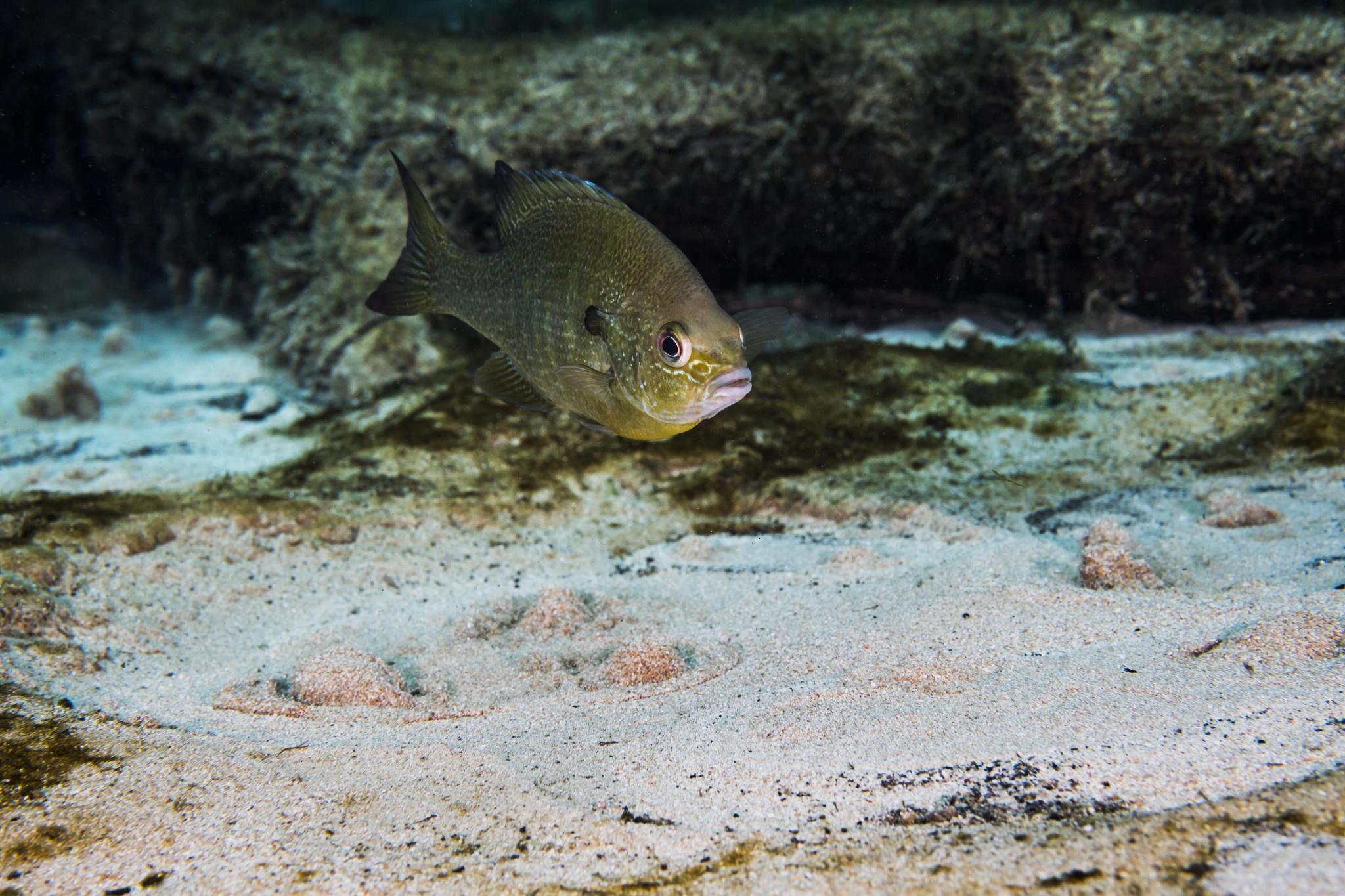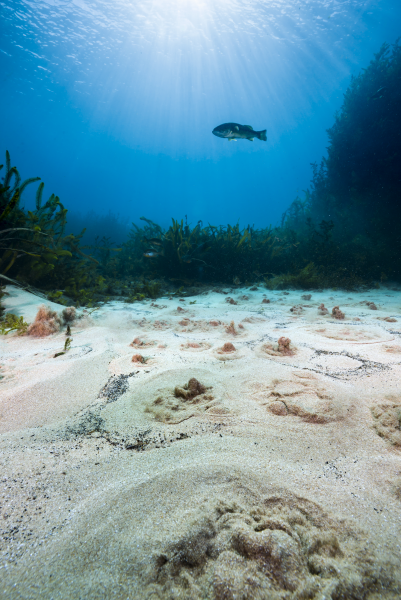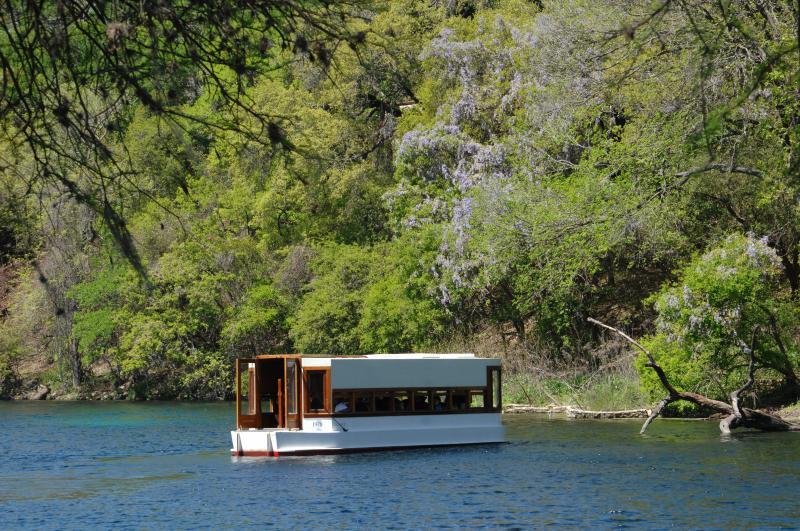
A fish hovers over Cream of Wheat Springs, some of the most spectacular of the low-pressure springs that form Spring Lake and the San Marcos River. Photos by Jennifer Idol/Meadows Center for Water and the Environment
Defining Our History
Editor’s Note: This story is reprinted from the Texas Water Development Board newsletter.
The Texas of 10,000 years ago was different from the Texas of today. There were no glistening skyscrapers or churning oil derricks; no frustrating traffic jams or buzzing airports; or no all-knowing interwebs or sizzling Whataburgers (ah, yes: the good ‘ole days — except for the lack of Whataburgers!). But Texas was like the Texas of today in that there was water — and there were people that relied upon it.
No one knows precisely when or how the first humans set foot in the Americas, but archaeologists generally agree that the first Americans walked across a land bridge connecting Siberia to Alaska during an ice age some 25,000 years ago. Not surprisingly, water factored strongly in where these paleo-Americans camped or settled. The oldest evidence of humans in Texas dates back to about 15,500 years ago at Buttermilk Creek near present-day Salado. It was not an accident that paleo-Americans settled there: perennial springflow provided a solid (actually liquid!) foundation upon which to establish a thriving community.
Similarly, springs across Texas confirm early human use. Evidence of inhabitation extends more than 10,000 years ago at Barton, Las Moras, Lubbock Lake, San Antonio, San Marcos, San Felipe and San Pedro springs. Native American trails —the superhighways of their time — connected one spring to the next, especially in the drier parts of the state. Early Americans handed down these springs — and many others — generation after generation, tribe after tribe, society after society.

Another view of the Cream of Wheat springs.
The earliest European explorers drank from many Texas springs. Álvar Núñez Cabeza de Vaca, in his exploration of the American Southwest in the 1530s, likely stopped at Cold and Verde springs in Bandera County; San Antonio and San Pedro springs in Bexar County; Kokernot Springs in Alpine; Colbath and Henderson springs in Kerr County; Coleman Springs in Coleman County; Comanche, West Escondido, and Pecos springs in Pecos County; and Fort Terrett Springs in Sutton County. Francisco Vázquez de Coronado may have visited springs in Dallam and Lubbock counties in 1542. Luis de Moscoso Alvarado probably enjoyed Buffalo Springs in Clay County in 1542. Antonio de Espejo probably stopped at Fort Davis, Saragosa, Giffin, and San Solomon springs in 1582. Gaspar Castaño de Sosa is believed to have visited Goodenough Springs in Val Verde County in 1590, and Juan de Oñate probably visited Bravo Springs in Oldham County in 1601.
As Franciscan missionaries moved into the area, church fathers — just as the Native Americans before them — chose townsites based on reliable water: the perennial streams and springs of the land. The first permanent settlement of Europeans in Texas was at Corpus Christi de la Isleta in 1682 along the Rio Grande at modern-day Ysleta. Other missions appeared at San Pedro Springs (San Antonio de Valero Mission, 1718); San Marcos Springs (San Xavier Mission, 1755); Comal Springs (San Francisco Xavier on Guadalupe Mission, 1756); Barton Springs (the San Francisco de los Tejas Mission, Nuestra Señora de la Purísima Concepción de los Hasinai, and San José de los Nazonis missions, 1730); and Old Faithful Spring (San Lorenzo de la Santa Cruz Mission, 1762).
Like pearls strung on a necklace, springs set the path for the famous cattle and cowboy trails across the state, including the Camino Real, the Chisolm Trail, the Old Spanish Trail, the Chihuahua Road, and the MacKenzie Trail. More than 200 towns sprang up around springs, often named after their water source, such as San Marcos at San Marcos Springs, Sulphur Springs at Sulphur Springs, Waco at Waco Springs, Big Spring at Big Spring, and Dripping Springs at Dripping Springs. Springs served as the rooting water for other towns such as Browder Springs in Dallas, Beauchamps Springs in Houston, San Felipe Springs in Del Rio, and Comal Springs in New Braunfels. A committee recommending the Austin area for the new capital of the Republic of Texas described Barton Springs as “perhaps the greatest and most convenient water power to be found in the Republic.”

An iconic glass bottom boat glides over the surface of Spring Lake as visitors experience the underwater environment. Daily Record photo by Anita Miller
Inevitably, springs have also been the focus of fights, both lethal and legal. When Spanish explorers visited Big Spring for the first time, the Comanche and Pawnee were battling to control the water source. Various militaries located forts at springs, which often involved skirmishing with Native Americans to control the watering holes. With the advent of affordable down-hole pumping and its subsequent impact on springflow, weapons of choice turned from lead to lawyers as springs dried-up — such as at Comanche Springs — or threatened to dry up —such as at Comal and San Marcos springs. Other springs were sadly forgotten: Dallas’ Browder Springs is now under Interstate 30 and Houston’s Beauchamps Springs rests under Interstate 10. Yet other springs whimpered away with increased pumping: Big Spring springs no more, Phantom Lake Springs is now a phantom, and the springs of Running Water Draw are no longer running. Gunnar Brune, in his TWDB report on Texas springs, noted that almost a quarter of the state’s 281 major and historically significant springs had failed by 1975.
In these modern times, springs are more appreciated: Barton Springs is celebrated as the spirit and soul of Austin, San Marcos and Comal springs are protected as habitat for endangered species, and stakeholders are joining to study and protect San Solomon Springs in West Texas. There is also greater appreciation for what springs mean culturally, economically, and environmentally to Texas and its varied water beneficiaries. Thousands of years later, as springs flow or don’t, Texas is still about people and water.











